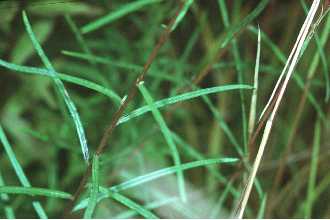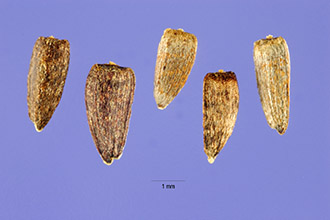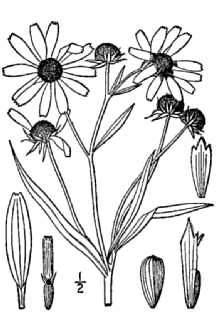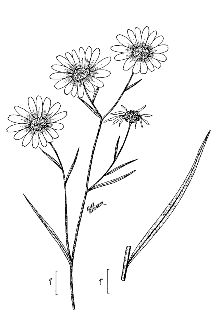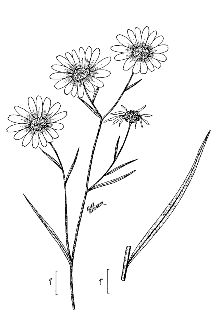Swamp Sunflower
Scientific Name: Helianthus angustifolius L.
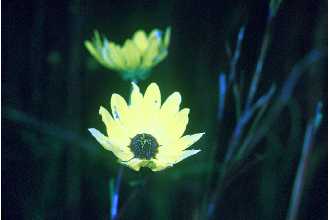
| General Information | |
|---|---|
| Usda Symbol | HEAN2 |
| Group | Dicot |
| Life Cycle | Perennial |
| Growth Habits | Forb/herb |
| Native Locations | HEAN2 |
Plant Guide
Description
General: Swamp sunflower is a native, warm season, perennial forb. Single or multiple branching stems arise each spring from a basal winter rosette and grow 3 to 6 feet tall (Fig. 1). Basal leaves may be opposite while upper leaves are alternately arranged (Fig. 2). Leaves are 3 to 8 inches long and vary from ⅛ inch wide in open sites to ¾ inch in shaded sites under timber. The narrow dark green leaves are covered with short, stiff hairs. Numerous blooms appear in October and range from 1.5 to 2 inches wide. The center disk is dark brown to purple and surrounded by bright yellow ray flowers. Seeds or achenes mature in November, and are less than a quarter inch long, flattened, dull black with tan markings (Grelen and Hughes, 1984; Eason, 2018) (Fig. 4). Swamp sunflower is known to intergrade with Florida sunflower (Helianthus floridanus) in southern Georgia and eastern Florida producing plants with yellow disks (Grelen and Hughes, 1984). Distribution: The Helianthus genus contains 150 sunflower species, most of which are native to North America (North Carolina State Extension, 2020a). Swamp sunflower is found from Texas to Missouri extending eastward to Florida and New York (Grelen and Hughes, 1984). For current distribution, please consult the Plant Profile page for this species on the PLANTS Web site. Habitat: Swamp sunflower is found on upland range sites to low, open flatwoods, and wet sites. It occurs on new forest plantations, open forests, old fields, and right-of-ways and prefers shaded areas such as woodland edges (Grelen and Hughes, 1984; Miller and Miller, 1999; Eason, 2018). Associated plants of swamp sunflower include pinehill bluestem (Schizachyrium scoparium var divergens), pineywoods dropseed (Sporobolus junceus), partridge pea (Chamaecrista fasciculata), hyssop-leaved bonset (Eupatorium hyssopifolium), pinkscale blazing star (Liatris elegans), sharp blazing star (L. acidota), prairie blazing star (L. pycnostachya), and whiteleaf mountain mint (Pycnanthemum albescens) in longleaf pine (Pinus palustris) habitat of eastern Texas (Evans, 2002). Natural Resources Conservation Service Plant Guide Figure 1. Swamp sunflower in bloom. Figure 2. Narrow alternately arranged swamp sunflower leaves. Photo credit: Larry Allain, U.S. Geological Survey.
Adaptation
Swamp sunflower is adapted to both upland and lowland sites that are slightly alkaline to acidic, with moist to wet sandy and clay loam soils in USDA Plant Hardiness Zones 8b through 10 (Gilman and Shiffit, 1999; Miller and Miller, 2005; North Carolina State Extension, 2020).
Uses
Native Pine Understory: Swamp sunflower is a common forb in the southeastern US (Miller and Miller, 2005 ) and is a suitable species for restoration due to its longevity and fire tolerance (USDA, NRCS, 2020). This forb, along with grassleaf goldaster (Heterotheca graminifolia) are the two most frequently occurring composites on Louisiana longleaf pine sites (Haywood and Harris, 1999). Wildlife: Wildlife and pollinators use swamp sunflower throughout the year. Young stems and leaves are high in protein and browsed by deer while seeds are consumed by quail and dove in winter (Grelen and Hughes, 1984). Swamp sunflower is the latest fall flowering sunflower (New Moon Nursery, 2020) and is a valuable late season nectar and pollen source for pollinator species. This forb is an important nectar source for southern migrating Monarch butterflies (Danaus plexippus) in Texas (USDA NRCS, 2017). Swamp sunflower is a host plant for Silvery Checkerspot (Chlosyne nycteis), Gorgone Checkerspot (C. gorgone), Bordered Patch (C. lacinia), and Painted Lady (Vanessa cardui) butterfly caterpillars (New Moon Nurseries, 2020) (Fig. 3). Native bees attracted to this forb include long horned bees (Melissodes communis and Svastra aegis), sweat bees (Agapostemon splendens, Halictus ligatus, H. poeyi, and Augochloropsis metallica fulgida), and leafcutter bees (Megachile albitarsis, M. mendica, M. parallela, M. petulans, and Coelioxys sayi) (Bartholomew et al., 2006; Buckley, 2011). Ornamental/Landscaping: Swamp sunflower provides bright color in fall and attracts butterflies and bees along with songbirds. This plant is a good component for butterfly gardens, pollinator gardens, and native landscapes (North Carolina State Extension, 2020).
Ethnobotany
Sunflower was commonly used among Native American tribes. Seeds were ground or pounded to make flour for bread or cakes. Sunflower meal was mixed with vegetables such as beans, squash, or corn, or eaten as a snack. Dyes from the plant were used for textiles, body painting and decoration (National Sunflower Association, 2020).
Status
Threatened or Endangered: Swamp sunflower is listed as threatened in Illinois, New York state, and Pennsylvania (USDA NRCS, 2020). Wetland Indicator: Swamp sunflower is considered a facultative wetland plant (FACW) in Atlantic and Gulf Coastal Plain, Eastern Mountains and Piedmont, Midwest, and Northcentral and Northeast regions but a facultative wetland plant (FAC) in Great Plains region. Facultative wetland plants usually occur in wetlands, but occasionally found in non-wetlands and a facultative plant occurs in wetlands and non-wetlands (US Army Corps of Engineers, 2018). Weedy or Invasive: This plant is a beneficial native forb and considered desirable within its natural habitat. Weediness is not anticipated with this species. Please consult with your local NRCS Field Office, Cooperative Extension Service office, state natural resource, or state agriculture department regarding its status and use. Please consult the PLANTS Web site (http://plants.usda.gov/) and your state’s Department of Natural Resources for this plant’s current status (e.g., threatened or endangered species, state noxious status, and wetland indicator values).
Planting Guidelines
Begin site preparation a year before seeding to increase stand establishment success. Prepare the planting site using a combination of either tillage, herbicide applications, prescribed burning, or mowing to control and eliminate weedy vegetation. Mowing and multiple herbicide applications may be required for effective control of weedy perennial species. Roll or cultipack to firm the soil surface if conventional tillage is used during planting site preparation. The final prepared seedbed for drill planting should be firm, weed free, and have adequate moisture before planting. For conservation plantings, plant swamp sunflower from December 1 to June 1 (USDA NRCS, 2018). Seed drills provide seeding depth control and good seed-to-soil contact and are the preferred method of planting. Swamp sunflower is a small seeded species, and planting depth is critical to achieve successful stands. Plant seed no more than ¼ inch deep. Use the legume box on the seed drill if so Figure 3. Caterpillar on swamp sunflower stem in fall.
Management
Conservation plantings can be managed by mowing to a height above established seedlings, applying a selective herbicide, or conducting prescribed burns to control undesirable weedy species and promote growth and establishment of native plant species. Contact your local agricultural extension specialist to learn what works best in your area and how to use it safely. Always read label and safety instructions for each control method. USDA NRCS does not guarantee or warranty the products and control methods named, and other products may be equally effective.
Pests and Potential Problems
Swamp sunflower is susceptible to spittle bugs (Philaenus sp.) and caterpillars and beetles chew on the foliage, but these pests rarely cause extensive damage (North Carolina State Extension, 2020; Gilman and Shiffit, 1999). Potential diseases include rust (Puccinia sp.), leaf fungal spots, and powdery mildew (Golovinomyces sp. and Podosphaera sp.) (North Carolina State Extension, 2020).
Environmental Concerns
Concerns
Concerns
Swamp sunflower is a desirable plant within its native range and has no known negative effects on the environment.
Control
Swamp sunflower is controlled by mechanical means such as mowing and tillage or applying a broad-spectrum or broad leaf selective herbicide. Contact your local agricultural extension specialist or county weed specialist to learn what works best in your area and how to use it safely. Always read label and safety instructions for each control method.
Seeds and Plant Production
Plant Production , Use soil moisture sensors to measure the soil moisture of Swamp Sunflower.
Plant Production
If equipment and facilities are available, the preferred method of establishing seed production fields is by growing seed in containers and transplant the seedlings to the field in the spring. Transplanting reduces time needed to achieve a uniform stand, efficiently uses limited seed, and allows use of pre-emergent herbicides which greatly reduce weed competition during establishment. Start swamp sunflower transplants by sowing seeds ¼ inch deep into transplanting containers about two months before the last freeze date. Grow in a greenhouse until plants become root bound in containers and move to a shadehouse or other outdoor sheltered area for two weeks to harden off before transplanting. Transplant seedlings at 18-inch intervals on 40-inch rows after frost danger has passed. Water as needed to reduce transplant shock and aid in establishment. Establish commercial seed production fields by seed following the Planting Guidelines in this document. Amend soil fertility based on soil test results and recommendations to improve seed production. Recommended row spacing is 40 inches for seed production fields. Space rows to allow weed control and seed harvesting equipment access, and to limit competition between plants. Irrigate as needed to maximize plant production and seed fill. Manage seed production fields by using shallow cultivation between rows, or applying a nonselective herbicide, such as glyphosate, with a hooded sprayer between rows during the growing season. After harvesting seed production fields, mow old stems and apply a preemergent herbicide on established fields to control cool season weeds. Harvest dates vary by year and location, but typically occur from late October to November. Harvest seed when easily hand threshed from dried seed heads but before they begin shattering. Combining is the recommended harvest method. The front concave setting should be approximately 9mm and the rear concave setting at approximately 4.5mm. Set cylinder speed at Figure 4. Swamp sunflower seeds. Photo credit: Steve Hurst, hosted by the USDA-NRCS PLANTS Database. 4 approximately 950 RPM and air speed set low. After harvest, scalp material to remove large debris, and spread seed on a concrete floor or tarp and use fans to circulate air over seed. Process seed using a cleaner with separation screens and air adjustments to remove leaves, stem pieces, and unfilled seed. Screen sizes and air adjustments may vary from year to year. The following screen settings are a starting point for a Westrup Laboratory Air/Screen model LA/LS (Hoffman Manufacturing, Corvallis, OR) seed cleaner; upper screen – 8mm, middle screen – 5 to 2mm, and bottom screen – 0.5mm. Seed material may need to be cleaned multiple times and the middle screen progressed from 5mm to 2mm with each cleaning process. Store cleaned seed in a controlled environment of 50º F and approximately 40% relative humidity for seed longevity. Cultivars, Improved, and Selected Materials (and area of origin) Cultivars and selections should be selected based on the local climate, resistance to local pests, and intended use. Consult with your local land grant university, local extension agent or local USDA NRCS office for recommendations on adapted cultivars for use in your area. Swamp sunflower is available from commercial sources. Cultivars or varieties include ‘Gold Lace’ which grows 5 to 6 feet tall (Babikow Greenhouses, 2020). Pineland Gold Germplasm is a composite of 11 accessions selected and released by the USDA NRCS East Texas Plant Materials Center and released in 2021 for use in native pine understory restoration and pollinator habitat enhancement.
Literature Cited
Babikow Greenhouses. 2020. Helianthus angustifolius ‘Gold Lace’. Accessed online: http://www.babikow.com Bartholomew, C., D. Prowell, and T. Griswold. 2006. An annotated checklist of bees (Hymenoptera: Apoidea) in longleaf pine savannas of southern Louisiana and Mississippi. Journal of the Kansas Entomological Society 79(2), pp. 184-198. Buckley, K. 2011. Native bee visitation on Florida native wildflowers. M.S. Thesis. University of Florida. Gainesville, FL. Eason, M. 2018. Wildflowers of Texas. Timber Press Field Guide. Timber Press. Portland, OR. Evans, R. 2002. Association Detail Report: CEGL008580 Pinus palustris/Quercus marilandica/Panicum virgatum Woodland. The U.S. National Vegetation Classification. US Department of Interior-United States Geological Survey. Reston, VA. Accessed: https://www1.usgs.gov/csas/nvcsGetUnitDetainls?elementGlobalId=685627 Gilman, E. and S. Shiffit. 1999. Helianthus angustifolius. Fact Sheet FPS-242. University of Florida Cooperative Extension Service. Gainesville, FL. Grelen, H. and R. Hughes. 1984. Common herbaceous plants of southern forest range. Res. Paper SO-210. US Forest Service. Southern Forest Experiment Station. New Orleans, LA. Grelen, H. and V. Duvall. 1966. Common plants of the longleaf pine-bluestem range. Res. Paper SO-23. US Forest Service. Southern Forest Experiment Station. New Orleans, LA. Haywood, J. and F. Harris. 1999. Description of vegetation in several periodically burned longleaf pine forests on the Kisatchie national forest. Proceedings of the Tenth Biennial Southern Silvicultural Research Conference. Shreveport, LA. February 18, 1999. Ladybird Johnson Wildflower Center. 2020. Helianthus angustifolius. Ladybird Johnson Wildflower Center. Austin, TX. Accessed online: https://www.wildflower.org/plants/result.php?_plant=HEAN2 Miller, J. and K. Miller. 1999. Forest plants of the southeast and their wildlife uses. Southern Weed Science Society. Craftmaster Printers. Auburn, AL. Miller, J. and K. Miller. 2005. Forest plants of the southeast and their wildlife uses. Rev. edition. University of Georgia Press. Athens, GA. National Sunflower Association. 2020. History of the amazing sunflower. National Sunflower Association. Mandan, ND. Accessed online: https://www.sunflowernsa.com/all-about/history/ New Moon Nurseries. 2020. Helianthus angustifolius. Accessed online: http://www.newmoonnursery.com/plant/Helianthus- angustifolia 5 North Carolina State Extension. 2020. Helianthus angustifolius. North Carolina Extension Gardener Plant Toolbox. NC State Extension. Raleigh, NC. Accessed online: https://plants.ces.ncsu.edu/plants/helianthus-angustifolius North Carolina State Extension. 2020a. Helianthus. North Carolina Extension Gardener Plant Toolbox. NC State Extension. Raleigh, NC. Accessed online: https://plants.ces.ncsu.edu/plants/helianthus/ US Army Corps of Engineers. 2018. Helianthus angustifolius. National wetland plant list v.3.4-species detail tool. Accessed online at: wetland-plants.usace.army.mil/nwpl_static/v34/species/species.html?DET=001100# USDA NRCS. 2017. Important plants of the monarch butterfly. Western coastal plain staff guide. USDA Natural Resources Conservation Service. USDA NRCS. 2018. Appendix 1- planting rate for seeding and sprigging in Texas, zone 4. NRCS Field Office Technical Guide. Accessed online: https://efotg.sc.egov.usda.gov/references/public/TX/Zone_4_Seeding_Table_Final.pdf USDA, NRCS. 2020. The PLANTS Database (http://plants.usda.gov, 16 November 2020). National Plant Data Team, Greensboro, NC 27401-4901 USA. Citation Brakie, M. 2021. Plant Guide for swamp sunflower (Helianthus angustifolius). USDA-Natural Resources
Conservation
Service, East Texas Plant Materials Center. Nacogdoches, TX. Published: March 2021 jld Aug/2021 For more information about this and other plants, please contact your local NRCS field office or Conservation District at http://www.nrcs.usda.gov/ and visit the PLANTS Web site at http://plants.usda.gov/ or the Plant Materials Program web site: http://plant-materials.nrcs.usda.gov. PLANTS is not responsible for the content or availability of other Web sites. In accordance with Federal civil rights law and U.S. Department of Agriculture (USDA) civil rights regulations and policies, the USDA, its Agencies, offices, and employees, and institutions participating in or administering USDA programs are prohibited from discriminating based on race, color, national origin, religion, sex, gender identity (including gender expression), sexual orientation, disability, age, marital status, family/parental status, income derived from a public assistance program, political beliefs, or reprisal or retaliation for prior civil rights activity, in any program or activity conducted or funded by USDA (not all bases apply to all programs). Remedies and complaint filing deadlines vary by program or incident. Persons with disabilities who require alternative means of communication for program information (e.g., Braille, large print, audiotape, American Sign Language, etc.) should contact the responsible Agency or USDA's TARGET Center at (202) 720-2600 (voice and TTY) or contact USDA through the Federal Relay Service at (800) 877-8339. Additionally, program information may be made available in languages other than English. To file a program discrimination complaint, complete the USDA Program Discrimination Complaint Form, AD-3027, found online at How to File a Program Discrimination Complaint and at any USDA office or write a letter addressed to USDA and provide in the letter all of the information requested in the form. To request a copy of the complaint form, call (866) 632-9992. Submit your completed form or letter to USDA by: (1) mail: U.S. Department of Agriculture, Office of the Assistant Secretary for Civil Rights, 1400 Independence Avenue, SW, Washington, D.C. 20250-9410; (2) fax: (202) 690-7442; or (3) email: program.intake@usda.gov. USDA is an equal opportunity provider, employer, and lender.
Plant Traits
Growth Requirements
| Temperature, Minimum (°F) | -28 |
|---|---|
| Adapted to Coarse Textured Soils | Yes |
| Adapted to Fine Textured Soils | No |
| Adapted to Medium Textured Soils | Yes |
| Anaerobic Tolerance | None |
| CaCO3 Tolerance | Medium |
| Cold Stratification Required | No |
| Drought Tolerance | Medium |
| Fertility Requirement | Low |
| Fire Tolerance | Medium |
| Frost Free Days, Minimum | 160 |
| Hedge Tolerance | None |
| Moisture Use | Medium |
| pH, Maximum | 7.0 |
| pH, Minimum | 4.0 |
| Planting Density per Acre, Maxim | 10912 |
| Planting Density per Acre, Minim | 3450 |
| Precipitation, Maximum | 65 |
| Precipitation, Minimum | 25 |
| Root Depth, Minimum (inches) | 6 |
| Salinity Tolerance | None |
| Shade Tolerance | Intermediate |
Morphology/Physiology
| After Harvest Regrowth Rate | Slow |
|---|---|
| Toxicity | None |
| Resprout Ability | No |
| Shape and Orientation | Erect |
| Active Growth Period | Spring and Summer |
| Bloat | None |
| Coppice Potential | No |
| Fall Conspicuous | Yes |
| Fire Resistant | No |
| Flower Color | Yellow |
| Flower Conspicuous | Yes |
| Foliage Color | Dark Green |
| Foliage Porosity Summer | Moderate |
| Foliage Porosity Winter | Porous |
| Fruit/Seed Color | Brown |
| Nitrogen Fixation | None |
| Low Growing Grass | No |
| Lifespan | Moderate |
| Leaf Retention | No |
| Known Allelopath | No |
| Height, Mature (feet) | 5.6 |
| Growth Rate | Moderate |
| Growth Form | Rhizomatous |
| Fruit/Seed Conspicuous | No |
| Foliage Texture | Medium |
Reproduction
| Vegetative Spread Rate | Moderate |
|---|---|
| Small Grain | No |
| Seedling Vigor | Medium |
| Seed Spread Rate | Moderate |
| Fruit/Seed Period End | Fall |
| Seed per Pound | 504000 |
| Propagated by Tubers | No |
| Propagated by Sprigs | Yes |
| Propagated by Sod | No |
| Propagated by Seed | Yes |
| Propagated by Corm | No |
| Propagated by Container | No |
| Propagated by Bulb | No |
| Propagated by Bare Root | No |
| Fruit/Seed Persistence | No |
| Fruit/Seed Period Begin | Summer |
| Fruit/Seed Abundance | Medium |
| Commercial Availability | Routinely Available |
| Bloom Period | Late Summer |
| Propagated by Cuttings | No |
Suitability/Use
| Veneer Product | No |
|---|---|
| Pulpwood Product | No |
| Post Product | No |
| Palatable Human | No |
| Palatable Graze Animal | High |
| Palatable Browse Animal | High |
| Nursery Stock Product | No |
| Naval Store Product | No |
| Lumber Product | No |
| Fodder Product | No |
| Christmas Tree Product | No |
| Berry/Nut/Seed Product | No |

